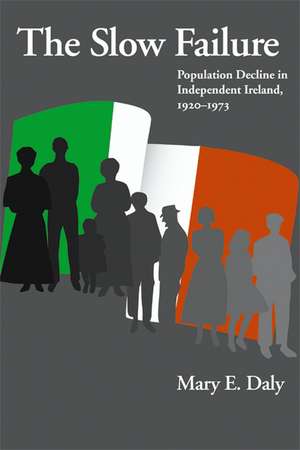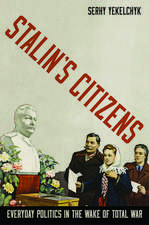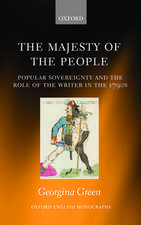The Slow Failure: Population Decline and Independent Ireland, 1920–1973: History of Ireland & the Irish Diaspora
Autor Mary E. Dalyen Limba Engleză Hardback – 22 feb 2006
Daly’s research reveals how pastoral visions of an ideal Ireland made it virtually impossible to reverse the fall in population. Promoting large families, for example, contributed to late marriages, actually slowing population growth further. The crucial issue of emigration failed to attract serious government attention except during World War II; successive Irish governments refused to provide welfare services for emigrants, leaving that role to the Catholic Church. Daly takes these and other elements of an often-sad story, weaving them into essential reading for understanding modern Irish history
Preț: 367.77 lei
Nou
Puncte Express: 552
Preț estimativ în valută:
70.37€ • 73.66$ • 58.57£
70.37€ • 73.66$ • 58.57£
Carte disponibilă
Livrare economică 10-24 martie
Preluare comenzi: 021 569.72.76
Specificații
ISBN-13: 9780299212902
ISBN-10: 0299212904
Pagini: 454
Ilustrații: 3 tables
Dimensiuni: 152 x 229 x 36 mm
Greutate: 0.8 kg
Ediția:1
Editura: University of Wisconsin Press
Colecția University of Wisconsin Press
Seria History of Ireland & the Irish Diaspora
ISBN-10: 0299212904
Pagini: 454
Ilustrații: 3 tables
Dimensiuni: 152 x 229 x 36 mm
Greutate: 0.8 kg
Ediția:1
Editura: University of Wisconsin Press
Colecția University of Wisconsin Press
Seria History of Ireland & the Irish Diaspora
Recenzii
“A valuable contribution on a central topic in modern Irish history from a leading historian of Ireland. The quality of the research is second to none.”—Enda Delaney, author of Irish Emigration since 1921
“A large and interesting account which provides a good analysis of the battle between perception and reality within Irish official circles and the failure of governments to compensate for economic realities.”—Donald M. MacRaild, Irish Economic and Social History
Notă biografică
Mary E. Daly is professor of history and dean of the Faculty of Arts, University College Dublin. Her many books include A Social and Economic History of Ireland since 1800;The Famine in Ireland;Industrial Development and Irish National Identity: 1922–39; and Women and Work in Ireland.
Descriere
Today Ireland’s population is rising, immigration outpaces emigration, most families have two or at most three children, and full-time farmers are in steady decline. But the opposite was true for more than a century, from the great famine of the 1840s until the 1960s. Between 1922 and 1966—most of the first fifty years after independence—the population of Ireland was falling, in the 1950s as rapidly as in the 1880s. Mary Daly’s The Slow Failure examines not just the reasons for the decline, but the responses to it by politicians, academics, journalists, churchmen, and others who publicly agonized over their nation’s “slow failure.” Eager to reverse population decline but fearful that economic development would undermine Irish national identity, they fashioned statistical evidence to support ultimately fruitless policies to encourage large, rural farm families. Focusing on both Irish government and society, Daly places Ireland’s population history in the mainstream history of independent Ireland.
Daly’s research reveals how pastoral visions of an ideal Ireland made it virtually impossible to reverse the fall in population. Promoting large families, for example, contributed to late marriages, actually slowing population growth further. The crucial issue of emigration failed to attract serious government attention except during World War II; successive Irish governments refused to provide welfare services for emigrants, leaving that role to the Catholic Church. Daly takes these and other elements of an often-sad story, weaving them into essential reading for understanding modern Irish history
Daly’s research reveals how pastoral visions of an ideal Ireland made it virtually impossible to reverse the fall in population. Promoting large families, for example, contributed to late marriages, actually slowing population growth further. The crucial issue of emigration failed to attract serious government attention except during World War II; successive Irish governments refused to provide welfare services for emigrants, leaving that role to the Catholic Church. Daly takes these and other elements of an often-sad story, weaving them into essential reading for understanding modern Irish history
























